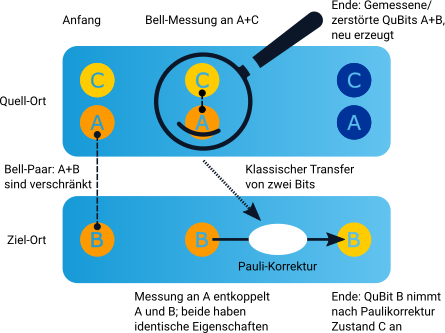Quantum Teleportation
Quantum Teleportation
Quantum teleportation via quantum gates is shown in the following two sketches schematically and as a circuit diagram consisting of CNOT, Hadamard and XZ gates [1,2]:

The goal of quantum teleportation is to transfer the state of QuBit C to another QuBit B. Due to the No-Cloning theorem it is however not possible to directly transfer the state of QuBit C to another QuBit without changing the state of QuBit C. The state of QuBit C is initially |QC>:
Therefore three QuBits are required for the execution of a quantum teleportation: QuBit C has the state to be transferred and the other two entangled QuBits (A and B) are used to transfer the state from QuBit C to QuBit B.
Sequence of a quantum teleportation
- Two QuBits A and B are entangled with each other. Bob keeps QuBit B and sends QuBit A to Alice.
- Alice concatenates her QuBit C with the received QuBit A via a CNOT gate and applies an Hadamard gate.
- Alice measures the states of QuBit C and QuBit A.
- Alice communicates the result of the measurements -encoded by two classical bits- via a classical communication channel.
- Depending on the measurement result Bob applies X and/or Z gates to his QuBit B to obtain the original state of QuBit C.
Mathematical description of step 1
The entanglement of QuBit A and B yields:
Thus together with QuBit C whose one-particle state is to be transferred, the state vector of the total system at 1. is given by:
Excursus: Description of the evolution of the total system.
In order to obtain a mathematical expression for the description of the evolution of the total system starting from the quantum gates used so far, we first investigate a system with two QuBits. We consider the case where QuBit q1 experiences a Hadamard gate while QuBit q0 is left undisturbed [3]:

No changes at QuBit q0 are described via the identity matrix I:
Matrix G that changes the state vector of both QuBits according to the above circuit is obtained from a tensor product of the matrices I and H:
For the used ordering of the entries in the state vector, G is obtained by taking the corresponding matrices in the circuit from top to bottom and combining them from left to right via a tensor product.
Mathematical description of step 2 and explanation of steps 3 and 4
Analogous to the case above with the QuBits q0 and q1, a description of the interaction of QuBit C with QuBit A via a CNOT gate is obtained from a tensor product between the matrices CNOT and I:
The description of the subsequent application of a Hadamard gate to QuBit C is obtained from the tensor product between the matrices H, I and I:
The state vector of the total system at 2. is obtained by applying G2G1 (normal matrix product!) to the state vector of the total system at 1.:
In the next step Alice performs a measurement on each of her two QuBits C and A. After the measurements she has one of the four states marked in green in the above equation with equal probability (25%). Alice sends the measurement result encoded in two classical bits to Bob, whose QuBit B assumes the corresponding state marked in blue due to the measurement:
| Measurement result C, A (Alice) | Qubit states |QC QA> after measurement (Alice) | QuBit state |QB> after measurment (Bob) |
| 0,0 | |00〉 | α|0〉+β|1〉 |
| 0,1 | |01〉 | α|1〉+β|0〉 |
| 1,0 | |10〉 | α|0〉-β|1〉 |
| 1,1 | |11〉 | α|1〉-β|0〉 |
Step 5: X and Z gates
Only in case of the measurement result 0,0 Bobs QuBit B directly takes the original state of QuBit C. In the other three cases, it is necessary to manipulate the state of QuBit B using the X and Z gates in order to recover the original state of QuBit C:
The X gate inverts the state from |0〉to |1〉and vice versa [1]:
The Z gate results in a change of state |+〉to |-〉or |-〉to |+〉[1]:
By using these gates Bob is able to recover the original state of QuBit C in his QuBit B. The following table shows which gates have to be applied to QuBit B depending on the measurement result:
| Measurement result C, A (Alice) | required gates for QuBit B (Bob) |
| 0,0 | none |
| 0,1 | X |
| 1,0 | Z |
| 1,1 | ZX |
Excursus: Mathematical representation of the X and Z gates.
The X gate is a simple 2×2 matrix. In this example the X gate changes the QuBit state |0〉to |1〉:
Also the Z gate is a simple 2×2 matrix. Shown is the change of |+> to |->:
Sources
[1] M. Ellerhoff. Mit Quanten Rechnen. ISBN 978-3-658-31221-3
[2] P. Kaufmann, S. Naegele-Jackson. II. Quantenrevolution – die Welt der Qubits. In: DFN Mitteilungen Issue 99, June 2021
[3] ibm. Qiskit Textbook. https://github.com/qiskit-community/qiskit-textbook
Version: 18.06.2024
